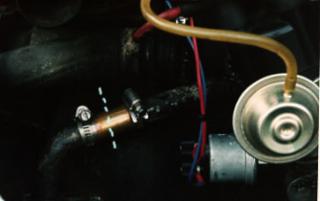 The photo is a tad dark. This operation took place with the stock carb and manifold, before the weber carb replacement. In the photo you see the stock heat riser, with a 3/4 inch copper pipe clamped on. The car was running bad, so I thought, maybe it's a cold manifold problem (not likely in summer - it turns out to have been vacuum leaks). Anyhow, I decided that the heat risers needed to work. They were totally blocked. Getting a wire around the bend is impossible. So, I cut off both ends with a reciprocating saw (aka SawsAll). The dotted line is approximately where the heat riser is cut. I shoved a coat hanger wire in there rotating constantly until I had drilled it through the blockage. Repeat on the other side. It's a tiring, dirty operation. Happily, 3/4 inch i.d. copper water pipe fits nicely as a sleeve to join the cut ends. I cut a slot in each end of the pipe, and clamped with hose clamps. Seemed to work well.
The photo is a tad dark. This operation took place with the stock carb and manifold, before the weber carb replacement. In the photo you see the stock heat riser, with a 3/4 inch copper pipe clamped on. The car was running bad, so I thought, maybe it's a cold manifold problem (not likely in summer - it turns out to have been vacuum leaks). Anyhow, I decided that the heat risers needed to work. They were totally blocked. Getting a wire around the bend is impossible. So, I cut off both ends with a reciprocating saw (aka SawsAll). The dotted line is approximately where the heat riser is cut. I shoved a coat hanger wire in there rotating constantly until I had drilled it through the blockage. Repeat on the other side. It's a tiring, dirty operation. Happily, 3/4 inch i.d. copper water pipe fits nicely as a sleeve to join the cut ends. I cut a slot in each end of the pipe, and clamped with hose clamps. Seemed to work well.Now that I've put heat risers in my new intake manifold, sealed in only with hi-temp silicon, I wonder if hi-temp silicon would have worked here?
